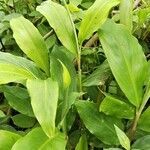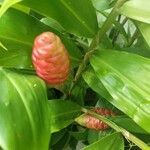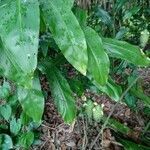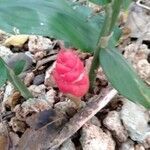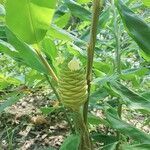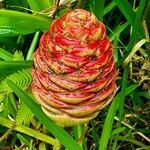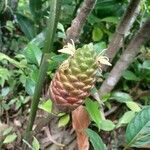An upright clumpy ginger family herb up to 0.4-1 m high. The rhizome is thick and yellow. The stems are stout. The leaves do not have a leaf stalk. Leaves are broadly sword shaped. The base is narrowed. They taper to the tip. The leaves are shorter and fatter than true ginger. They are 15-40 cm long by 3-8 cm wide. The flower cone is also longer and thinner than true ginger. The flower comes from the rhizome and is cone shaped and 6-15 cm long by 3.5-5 cm wide. The stalk is 10-30 cm long. The sheaths are scale like. The bracts are green when young and red when old. The fruit is a capsule which is 0.8-1.2 cm across. The seeds are black.
Leaf blades oblanceolate or narrowly elliptical, 30--32 ´ 6--7 cm (smaller distally). Inflorescences erect, 7--11 ´ [3--]5--6 cm; bracts of main axis green when young, becoming red; proximal bracts reniform or very broadly ovate, concave, 2--3 ´ 3--4 cm, apex broadly rounded; distal bracts smaller but otherwise similar to proximal bracts, ca. 1 ´ 2 cm. Flowers: perianth and staminodes pale yellow.
Plant to 2 m tall. Leaves lanceolate, shortly acuminate, to 6 cm wide; ligule entire. Inflorescence ovate-oblong, c. 7 cm long and wide, on peduncle to 50 cm long. Flowers yellow. Labellum emarginate, white or yellow.
